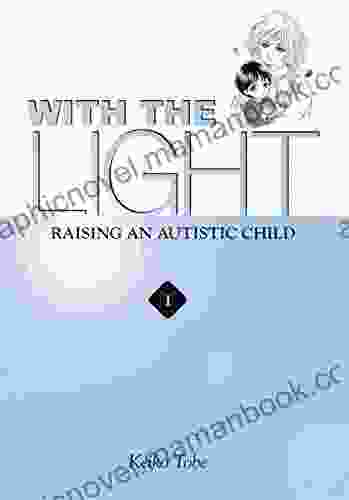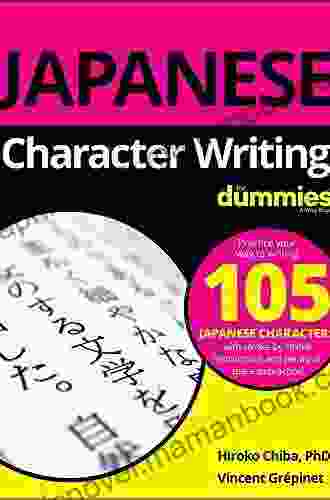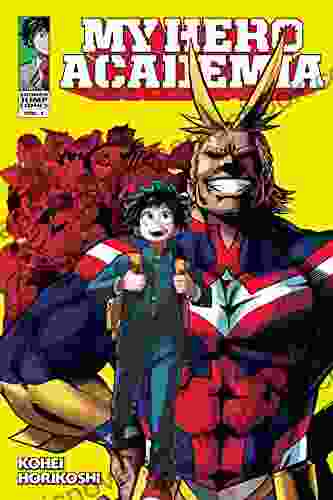Japanese Character Writing For Dummies: A Comprehensive Guide to Mastering Hiragana, Katakana, and Kanji

Japanese is a fascinating and rewarding language to learn, and mastering its unique writing system is an essential part of the journey. Japanese character writing consists of three main components: hiragana, katakana, and kanji. This guide will provide a comprehensive overview of each component, making Japanese character writing accessible to learners of all levels.
4.6 out of 5
| Language | : | English |
| File size | : | 7821 KB |
| Text-to-Speech | : | Enabled |
| Screen Reader | : | Supported |
| Enhanced typesetting | : | Enabled |
| Print length | : | 91 pages |
| Lending | : | Enabled |
Hiragana: The Basics of Japanese Phonetics
Hiragana is a syllabary, meaning that each character represents a syllable. It is primarily used for writing Japanese words that do not have corresponding kanji characters. Hiragana characters are cursive and flowing, with a soft, melodic quality. There are 46 basic hiragana characters, which can be combined to form a wide range of syllables.
Learning hiragana is essential for building a solid foundation in Japanese writing. Its simplicity and phonetically-based system make it an accessible starting point for beginners.
Learning Hiragana:
- Start with the basic strokes: Hiragana characters are composed of a few basic strokes that are repeated in various combinations. Mastering these strokes will provide a strong foundation for writing hiragana.
- Practice writing individual characters: Once you have the strokes down, begin practicing writing each hiragana character individually. Use a pencil or pen and paper, or utilize online handwriting practice tools.
- Combine characters to form words: As you become more proficient, start combining hiragana characters to form simple words. Reading and writing sentences will reinforce your understanding of the phonetic system.
With patience and consistent practice, mastering hiragana will become second nature, opening up a world of Japanese vocabulary and communication.
Katakana: The Writing System for Foreign Words
Katakana is another syllabary, but it is primarily used to write foreign words, loanwords, and onomatopoeia. Katakana characters are more angular and geometric than hiragana, with a sharp and distinct appearance. Similar to hiragana, there are 46 basic katakana characters.
Katakana is less commonly used than hiragana, but it plays a significant role in expanding Japanese vocabulary. With its ability to represent foreign sounds and concepts, katakana has become an integral part of modern Japanese writing.
Learning Katakana:
- Associate characters with their sounds: Katakana characters are phonetically-based, so focus on associating the unique shapes with their corresponding sounds.
- Practice writing individual characters: As with hiragana, practice writing individual katakana characters to develop muscle memory and improve accuracy.
- Explore Japanese media: Katakana is widely used in Japanese media, such as manga, anime, and TV shows. Exposing yourself to these mediums will improve your recognition and understanding of katakana.
Mastering katakana will increase your vocabulary and enhance your ability to navigate Japanese popular culture.
Kanji: The Complex World of Chinese Characters
Kanji are Chinese characters that have been adopted into the Japanese writing system. They can represent whole words, morphemes, or concepts, and their meanings can be complex and nuanced.
There are thousands of kanji in the Japanese language, and they form the backbone of written Japanese. Mastering kanji requires dedication and a systematic approach. However, the rewards are substantial, as kanji provide access to a vast world of Japanese literature, history, and culture.
Learning Kanji:
- Start with the basics: Begin by learning the most common and fundamental kanji. These characters are often used in everyday writing and will provide a solid foundation.
- Break down kanji into components: Many kanji are composed of smaller components called radicals. Understanding these radicals will aid in memorization and recognition.
- Practice writing kanji regularly: Consistency is key when learning kanji. Regular writing practice will improve your muscle memory and reinforce the shapes and strokes.
- Use mnemonic devices: Create stories, images, or associations to help you remember the meanings and pronunciations of kanji.
Mastering kanji is a challenging but rewarding endeavor. With patience, dedication, and effective learning strategies, you can unlock the richness and depth of the Japanese language through its written form.
Integrating Character Writing into Your Japanese Learning Journey
To effectively master Japanese character writing, it is crucial to integrate it into your overall language learning journey. Here are a few practical tips:
- Immerse yourself in Japanese media: Surround yourself with Japanese books, manga, newspapers, and websites. By exposing yourself to authentic Japanese texts, you will subconsciously absorb the various uses and combinations of characters.
- Use flashcards and writing practice: Regularly review and practice writing hiragana, katakana, and kanji characters using flashcards and writing exercises. This will reinforce your memory and improve your accuracy.
- Don't be afraid to ask for help: If you encounter difficulties or have questions, don't hesitate to consult with a native speaker, language tutor, or online resources. Seeking guidance can clarify misunderstandings and accelerate your learning.
Remember, learning Japanese character writing is a gradual process. With patience, consistency, and a genuine interest in the language and culture, you will make steady progress and unlock the full potential of Japanese communication.
Japanese character writing is an intricate and fascinating aspect of the Japanese language. By mastering hiragana, katakana, and kanji, you will gain the ability to read, write, and communicate effectively in Japanese. With the guidance provided in this comprehensive guide, you can embark on the journey of Japanese character writing with confidence and enthusiasm.
Remember, the key to success lies in consistent practice, immersion, and a deep appreciation for the written form of the Japanese language.
4.6 out of 5
| Language | : | English |
| File size | : | 7821 KB |
| Text-to-Speech | : | Enabled |
| Screen Reader | : | Supported |
| Enhanced typesetting | : | Enabled |
| Print length | : | 91 pages |
| Lending | : | Enabled |
Do you want to contribute by writing guest posts on this blog?
Please contact us and send us a resume of previous articles that you have written.
 Top Book
Top Book Novel
Novel Fiction
Fiction Nonfiction
Nonfiction Literature
Literature Paperback
Paperback Hardcover
Hardcover E-book
E-book Audiobook
Audiobook Bestseller
Bestseller Classic
Classic Mystery
Mystery Thriller
Thriller Romance
Romance Fantasy
Fantasy Science Fiction
Science Fiction Biography
Biography Memoir
Memoir Autobiography
Autobiography Poetry
Poetry Drama
Drama Historical Fiction
Historical Fiction Self-help
Self-help Young Adult
Young Adult Childrens Books
Childrens Books Graphic Novel
Graphic Novel Anthology
Anthology Series
Series Encyclopedia
Encyclopedia Reference
Reference Guidebook
Guidebook Textbook
Textbook Workbook
Workbook Journal
Journal Diary
Diary Manuscript
Manuscript Folio
Folio Pulp Fiction
Pulp Fiction Short Stories
Short Stories Fairy Tales
Fairy Tales Fables
Fables Mythology
Mythology Philosophy
Philosophy Religion
Religion Spirituality
Spirituality Essays
Essays Critique
Critique Commentary
Commentary Glossary
Glossary Bibliography
Bibliography Index
Index Table of Contents
Table of Contents Preface
Preface Introduction
Introduction Foreword
Foreword Afterword
Afterword Appendices
Appendices Annotations
Annotations Footnotes
Footnotes Epilogue
Epilogue Prologue
Prologue Roberto Finelli
Roberto Finelli Joseph E Stiglitz
Joseph E Stiglitz Peter Lant
Peter Lant Holly Black
Holly Black Beverley Courtney
Beverley Courtney Fanny Kelly
Fanny Kelly Michael B Berkman
Michael B Berkman Hayan Charara
Hayan Charara Veronica Bidwell
Veronica Bidwell Henry Thomas Hamblin
Henry Thomas Hamblin Laurence Leamer
Laurence Leamer Melissa Crandall
Melissa Crandall Nobuhiro Watsuki
Nobuhiro Watsuki Tracey Devlyn
Tracey Devlyn Matt Lincoln
Matt Lincoln J R Pace
J R Pace Denis Stokes
Denis Stokes Bernard Knight
Bernard Knight Sarah Bell
Sarah Bell Elizabeth L Cline
Elizabeth L Cline
Light bulbAdvertise smarter! Our strategic ad space ensures maximum exposure. Reserve your spot today!
 Ben HayesFollow ·16.2k
Ben HayesFollow ·16.2k Vic ParkerFollow ·10.4k
Vic ParkerFollow ·10.4k Reed MitchellFollow ·3.5k
Reed MitchellFollow ·3.5k Geoffrey BlairFollow ·14.1k
Geoffrey BlairFollow ·14.1k Forrest ReedFollow ·19.1k
Forrest ReedFollow ·19.1k Anthony BurgessFollow ·15.5k
Anthony BurgessFollow ·15.5k Caleb CarterFollow ·18k
Caleb CarterFollow ·18k Jordan BlairFollow ·16.4k
Jordan BlairFollow ·16.4k

 Rex Hayes
Rex HayesWorld of Dead Volume Issue: An In-Depth Analysis
The World of Dead volume issue...

 Nathan Reed
Nathan ReedHard Lessons Learned from ERP Rollouts: A Hivemind...
Enterprise...

 Fernando Bell
Fernando BellWith the Light, Vol. 1: Illuminating the Extraordinary...
The advent of parenthood is a...

 Wesley Reed
Wesley ReedNo Helping Hand: True Story of Deadly Waves
In December 2004,...

 Ruben Cox
Ruben CoxIntroduction to Electrodynamics by David Griffiths: A...
to Electrodynamics by...
4.6 out of 5
| Language | : | English |
| File size | : | 7821 KB |
| Text-to-Speech | : | Enabled |
| Screen Reader | : | Supported |
| Enhanced typesetting | : | Enabled |
| Print length | : | 91 pages |
| Lending | : | Enabled |













